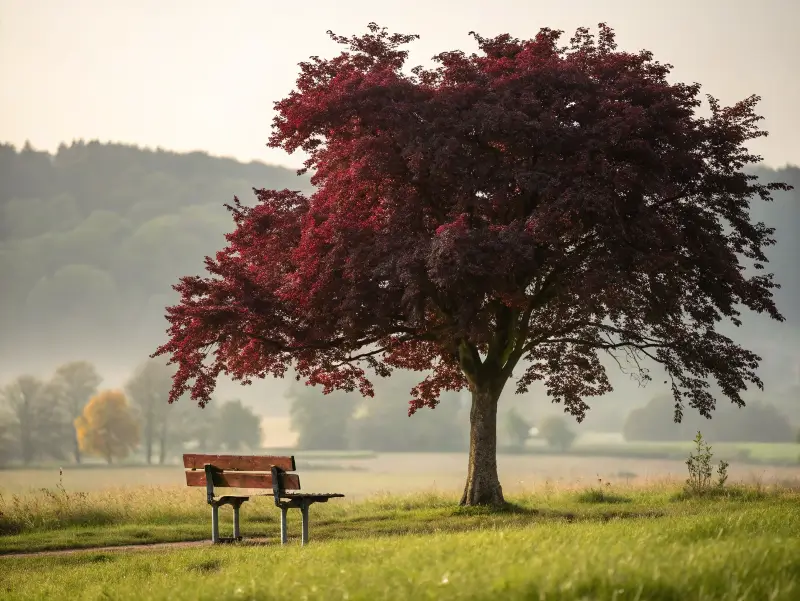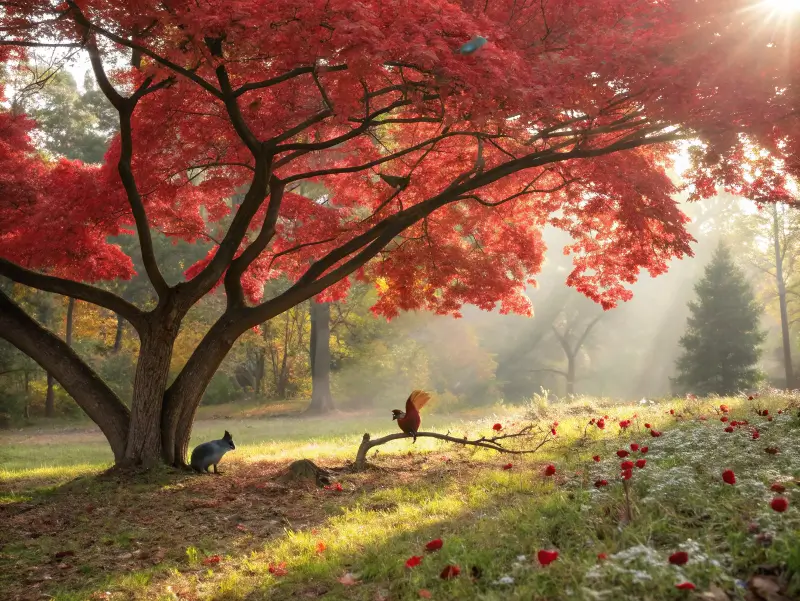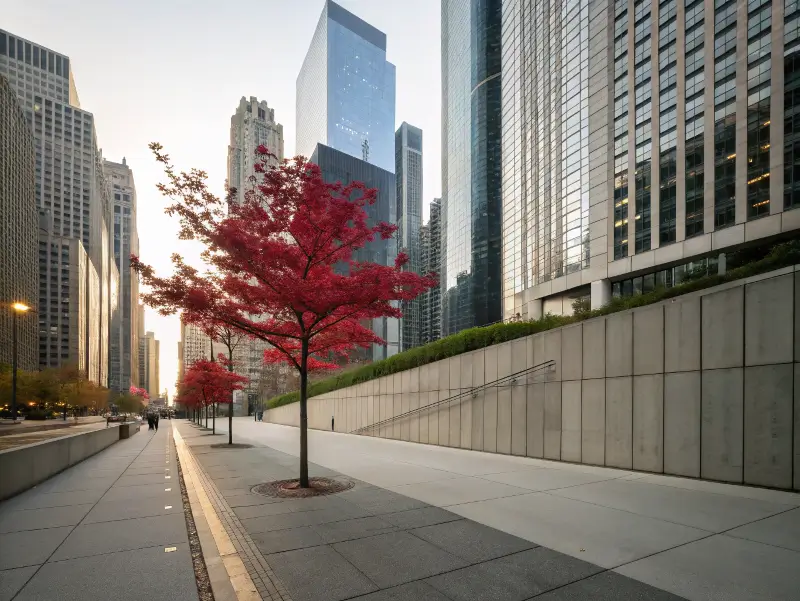
I’ve been fascinated by the red tree for what feels like ages. There’s something totally hypnotic about these brightly colored wonders, especially during spring when nature is waking up. In this article, I’ll share the origin of this unique plant, its cultural role, fun ways to plant one at home, and my own tales of discovering these bold beauties in different places. You’ll see how the red tree can turn a dull corner into a lively spot and why I think it’s worth adding to any yard or park. Let’s jump right in and get to know these spectacular icons!
Introduction to the Red Tree Phenomenon
The Symbolic Beauty of Red Trees
I’ve always believed that a red tree can light up the most ordinary space. In many areas, these grand eye-catchers spark curiosity among neighbors and passersby. That bright trunk and those vivid leaves seem to say, “Look at me!” which is kind of awesome if you want a centerpiece in your yard. Honestly, my friends joke that I can spot a red tree a mile away because I adore that punch of color.
- Many cultures see a red tree as a sign of energy and warmth.
- Some neighborhoods feature them in main squares to boost local pride.
- Plant lovers like me admire how quickly they stand out among green shrubs.
Whenever I chat with fellow garden enthusiasts, they talk about that uplifting feeling they get while gazing at these fiery leaves. It’s like a reminder that nature can be bold and comforting at the same time.
Early Historical References to Red-Hued Trees
Centuries ago, travelers wrote stories of communities gathering by a red tree to celebrate seasonal changes. They often described how this colorful trunk looked magical in low sunlight. Locals might have used the bark for natural dyes or even used the bright leaves in traditional ceremonies.
- Written records mention a red tree as a symbol of celebration and hope.
- In older lore, scarlet bark was prized for its striking shade.
- People sometimes connected this plant to good fortune or protection.
Varieties and Types of Red Trees Across the Globe
Famous Species: A Closer Look at Maple, Beech, and Redwood
When you think about a red tree, a few major species usually top the list:
- Red maple: Known for its dramatic leaf color each fall.
- Red beech: Often has a deep, wine-like tone that looks amazing in large yards.
- Redwood: A colossal presence beloved for its tall, breathtaking trunk.
I remember when I first saw a red maple. I couldn’t believe how vividly the leaves flashed in the afternoon sun. Then there’s the red beech, which leans into darker shades—a nice choice if you want a less flashy but still dazzling look.
Unique Ornamental Red Tree Species for Landscaping
If you crave something decorative, you might pick smaller ornamental forms. It’s pretty neat to see:
- Japanese maples with their delicate, airy leaves.
- Ornamental cherries that produce pinkish-red blooms in spring.
- Certain crabapple varieties, offering pops of color around flowering time.
These plants work nicely in cozy yards or deck gardens. I’ve placed a Japanese maple in a large pot before, giving my front porch a subtle dash of crimson. It quickly became my favorite conversation starter when friends visited.
The Red Tree in Art and Literature

“The Red Tree” in Paintings and Visual Arts
Artists throughout history have devoted entire collections to a single red tree. They find the contrast of a bright trunk against soft backgrounds especially appealing. Galleries sometimes stage these paintings as focal points because the red hue demands attention.
- A single trunk can symbolize inner strength or raw passion.
- Bold color themes like bright crimson remind viewers of life’s intensity.
- Some local art fairs spotlight new artists who feature these plants in their creative pieces.
I once saw a painting that showed a red tree amid calm, blue hills. The effect was stunning—like a jolt of energy right on the canvas.
Notable Literary Works Featuring Red Trees
Writers often use these plants to mark a turning point in a story. A character might spot a crimson trunk right before making a life-altering decision. Myths sometimes place a red tree at the edge of a mystical forest, suggesting a link to hidden worlds or secret powers.
- Novels might treat a red tree as a guiding landmark.
- Folk tales depict it as a guardian of sacred spots.
- Poetry sets the bright plant as a metaphor for rebirth or hidden strength.
I’m drawn to how literature captures the fiery presence of these trees, turning them into a dramatic symbol of change.
Cultural and Spiritual Significance of the Red Tree
Red Trees in Mythology and Folklore
Legends abound with stories of a red tree showing up during special seasons—maybe under a rare moon or during magical nights. Some people say it holds mystical properties that protect travelers from harm.
- Ancient beliefs claimed a living red tree guided those who felt lost.
- Certain cultures painted these trunks during big communal celebrations.
- Others saw red bark as a shield against negative forces.
I enjoy researching old folktales because I think they add a deeper layer to everyday plants. It’s cool to see how historical communities viewed these colored wonders.
Symbolic Meanings in Various Traditions
In different parts of the world, a red tree might stand for passion, newfound strength, or even the promise of better times ahead.
- Couples sometimes plant one to celebrate unity or lasting love.
- The bold hue can suggest courage in the face of hardship.
- Festivals might revolve around planting new saplings to welcome spring.
I have a friend who places small figures at the base of her tree to honor family events. It’s her way of blending old beliefs with modern life.
Environmental and Ecological Roles of Red Trees

Biodiversity Benefits of Crimson Foliage
A red tree offers more than pretty scenery. Wildlife finds shelter and nesting areas among those branches—plus the fallen leaves keep the soil richer.
- Birds build hidden homes in thicker canopies.
- Decomposed foliage creates a fertile ground for new plants.
- Pollinators can benefit when blossoms appear.
I’ve watched squirrels scurry around in the branches, stashing nuts like they own the place. It’s a reminder that nature thrives when plant diversity is high.
Climate Impact: The Role of Red-Hued Trees in Urban Landscapes
Planting these beauties in a city can bring fresh air and cooler shade in hot spots. Locals who picnic in parks often choose a shady spot under a sprawling canopy. The U.S. Department of Agriculture has info on how trees—especially colorful ones—support greener communities.
- They help cut down on the heat swirling through concrete zones.
- They can offset some pollution by filtering the air.
- Green spaces with a red tree or two can lift moods for residents.
It’s always fun to see folks gather under a bright trunk on a weekend. Who doesn’t love a splash of red in a gray city street?
Planting and Caring for a Red Tree
Soil, Sunlight, and Water Requirements
I’ve learned that choosing the right soil for a red tree is key. Most varieties want slightly acidic to neutral conditions, which you can test quickly with a store-bought kit.
- Keep the ground well-draining to prevent soggy roots.
- Many red-hued species like partial to full sun.
- A solid watering routine—once a week or so—keeps them happy.
If you’re in a spot with scorching summers, consider giving your tree a partial-shade break in the hottest afternoon hours. Adding compost helps keep the plant vibrant. Sometimes, I toss a bit of mulch around the trunk to hold moisture and control weeds.
Tree Maintenance, Pruning, and Disease Prevention
I typically prune dead or crossing branches from my red trees in late winter. That way, they burst into spring with healthy new growth.
- Use clean shears to avoid passing along infections.
- Check for pests like aphids, spider mites, or caterpillars.
- Spray with gentle solutions if you notice leaf damage.
It’s wise to do a quick inspection every couple of weeks. If you see issues early, you can address them before they spread. A daily glance can do wonders—just step outside, give your tree a friendly look, and you’re golden. Low-key tasks like these let you enjoy the process of caring for such a bright piece of nature.
Spotlight on “Redwood” and Other Large Red Trees
What Kind of Tree Is a Redwood?
Redwoods are legendary. They can stretch hundreds of feet tall and live for centuries, making them one of the mightiest red trees around.
- Their bark has a distinct, warm tone that leans toward brownish-red.
- Most thrive along the West Coast, forming some of the planet’s tallest forests.
- These giants create habitats for countless species perched high in the canopy.
Standing next to a redwood for the first time is mind-blowing. I remember feeling tiny yet strangely comforted by their age and sturdiness.
Old-Growth Redwoods and Their Ecosystems
Old-growth stands hold entire mini-worlds in their upper branches. Owls, salamanders, and rare plants coexist up there, never setting foot on the ground. Preserving these places is crucial for overall forest conservation.
- Redwoods store a bunch of carbon, which is good for air quality.
- Saving these majestic spots also protects rare wildlife.
- Many nature lovers trek into redwood forests for that “wow” moment of awe.
When I visited, I was in such a good mood just gazing up. It’s a bit like stepping into a storybook, except everything is real—and massive.
The Red Tree in Modern Urban Spaces

The Red Tree in NYC and Other Metropolises
Big cities might seem like the last place you’d find a red tree. But in many urban parks, rooftop gardens, or renovated lots, these bold plants stand out. On a windy day, their branches sway above restless traffic, forming a striking visual treat.
- Some public art installations include a crimson trunk for extra flair.
- Certain sidewalks hold smaller trees that pack a punch of color.
- The bright hue contrasts with concrete and glass surroundings.
And you know what? In downtown areas, an occasional red tree next to a food truck or bench can make a drab block feel inviting. City dwellers appreciate a little natural color in their day.
Landscaping Trends and Urban Forestry Initiatives
Planners now realize that trees—especially colorful ones—benefit local climates and reduce stress. Initiatives encourage folks to plant more, benefiting everything from pollinators to dog-walking routes.
- “Green corridors” in bustling areas can include bold trunks for visual variety.
- Community events often bring neighbors together to plant new saplings.
- Advocates say a well-chosen shade tree lowers cooling costs for nearby buildings.
People no longer overlook bright species in the city—these lively trunks and leaves remind us that nature can thrive wherever we live.
FAQs About the Red Tree
What Is the Red Tree Called?
It’s a flexible term. it can be any that features notable crimson or ruby-hued foliage or bark, such as:
- Red maples
- Red beech
- Redwood
- Various ornamental hybrids
Each one has unique features, but they share that trademark burst of color.
What Is the Meaning Behind the Red Tree?
Many people see a red tree as a symbol of renewal or passion.
- It can stand for bravery and energy in certain cultures.
- Some families plant them to celebrate milestones.
- Others believe the color brightens the overall vibe of a property.
Frankly, I just love how it looks like a living piece of art.
What Is the Red Tree in NYC?
People sometimes refer to art pieces that focus on a single crimson trunk or special landscaping projects in famous parks. An eye-catching specimen can draw visitors to an otherwise overlooked area.
What Kind of Tree Is Redwood?
A redwood is a towering conifer. It’s one of the world’s tallest species—living for hundreds of years and storing a lot of carbon.
Conclusion: Embracing the Allure of the Red Tree
Future Outlook: Protecting and Celebrating Red Trees
I see this tree as more than just a pretty face. By planting them in gardens, parks, and even city regions, we support local wildlife and add bursts of life to our surroundings.
- Joining local programs can spread these trees to new areas.
- Moments spent under a bright trunk can relieve stress or spark creativity.
- Every new sapling marks another step toward improving our planet’s greenery.
You might even check out other interesting plant finds, like a Japanese Blueberry Tree—it has its own unique style—or a King Palm Tree if you prefer a tropical look.
Encouraging Awareness and Appreciation
Caring for a red tree can be a simple act, yet it brings happiness to anyone passing by. These trees give us color, shade, and a gentle reminder that nature’s brilliance is all around.If you have space for a new sapling, why not go for one that adds a splash of flair to your backyard? I personally love strolling outside, morning coffee in hand, admiring that pop of crimson among the flower beds. It’s a feeling I hope everyone can experience, whether they’re in a rural spot or a busy urban block.
